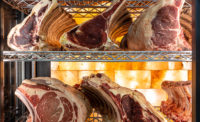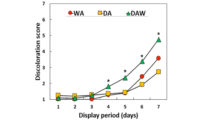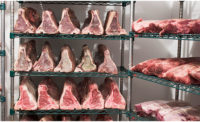Meat Science Review
Hunting compounds crucial to dry aging flavor
Further investigation of dry-aging effects on palatability attributes and metabolomics profiles of beef loins.

Dry aging is a traditional aging method in which primal or sub-primal sections of the carcass are stored in a controlled environment for several weeks without any type of packaging material. Dry aging is well known for enhancing meat palatability attributes. In particular, unique flavor development through dry aging such as beefy, nutty, brown-roasted or buttery is a major driver of dry-aging practice. In a recent study conducted in the Meat Science and Muscle Biology laboratory at Purdue University, dry aging resulted in improvement of meat palatability of low-marbled, grass-fed beef loins. This study suggested that dry aging can be an effective post-harvest value-adding strategy to provide consistent, desirable palatability characteristics of grass-fed beef with low marbling. While positive effects of dry aging on meat quality attributes have been reported in several scientific studies, specific chemical compounds associated with this unique dry-aging flavor have not been fully established.
Metabolomics is an emerging analytical technique that enables the detection and measurement of small molecular compounds, such as amino acids and sugars. Previous studies have shown that different muscle types have different metabolomics profiles, indicating the feasibility of identifying specific compounds related to meat quality. We hypothesized that chemical compounds associated with dry-aged flavor, or other palatability attributes, could be identified by using the metabolomics approach. Therefore, the objective of this study was to identify key compounds associated with eating quality attributes of dry-aged beef via metabolomics analysis. This study was a further investigation of our previous study, in which significant improvements in eating quality attributes were found in low-marbled, grass-fed beef loins through dry aging.
For this study, beef loins from nine beef carcasses were obtained at seven days postmortem. Loins were then cut into two sections, randomly assigned to three aging methods (wet aging, dry aging and dry aging in a water-permeable bag) and aged for 28 days at 35 degrees Fahrenheit and 78 percent relative humidity. After aging, samples were trimmed, and multiple steaks from each section were collected for both consumer sensory analysis and chemical analyses including metabolomics, volatile compounds and fatty acid profiling. The consumer panel was asked to provide both liking scores and additional descriptive comments on eating quality attributes. The frequency of positive comments from all provided responses were then quantified for further frequency analysis of each attribute. Metabolomics analysis was conducted using Ultra Performance Liquid Chromatography — Mass Spectrometry system, and relative abundance of metabolites was quantified for the statistical analyses. All data were analyzed using SAS, and further analysis using principle component analysis (PCA) was conducted using R software.
A total of 1,666 metabolites were detected, of which 125 metabolites were found to be significantly associated to aging-type treatments. The PCA analysis was conducted to observe the clustering and separation of the metabolites. A distinct separation between the wet-aging and dry-aging metabolomics profile was found (Figure 1). Further separation of clusters between the different dry-aging treatments (dry aging and dry aging in the water permeable bag) was also observed (Figure 1). Higher abundance of glutamate and glutamine compounds were detected in both dry-aging treatments, which could be potentially related to the flavor development of dry-aged products. Further, abundance of specific flavor-related compounds such as thiamine, thiazole and bisjuglone were detected in dry-aged beef. More antioxidant related compounds such as carnitine and glucosides were observed in wet aging, indicating possibly less oxidation in the treatment.
For volatile compound analysis, volatiles related to dry-aged flavor, such as methanethiol, pentanedione and heptanone, were identified and found to be more abundant in dry-aged product. No significant difference in fatty acid profile was observed among the different treatments. Based on the frequency analysis of the consumer sensory comments, higher frequency of positive comments (e.g. good, strong and/or beefy) was given to both dry aging and dry aging in the water-permeable bag for all traits except aroma when compared with wet aging.
The results of the current study indicate higher flavor-related metabolites and compounds were released through the dry-aging process, and those can be attributed to the unique dry-aged beef flavor. Through further understanding of these compounds, potential indicators of dry-aging process could be identified in order to optimize the process and to provide consistently high-quality dry-aged products to the consumers. NP
Author Notes:
Derico Setyabrata1, Jiwon Lee2, Silvana Martini2, Jerrad Legako3, Tiago J.P. Sobreira4, Yuan H. Brad Kim1*
- Meat Science and Muscle Biology Lab, Department of Animal Sciences, Purdue University, West Lafayette, IN, USA;
- Department of Nutrition, Dietetics, and Food Science, Utah State University, Logan, UT, USA
- Department of Animal and Food Science, Texas Tech University, Lubbock, TX, USA;
- Bindley Bioscience Center, Purdue University, West Lafayette, IN, USA
* Corresponding author: Brad Kim, Assistant Professor (bradkim@purdue.edu)
Looking for a reprint of this article?
From high-res PDFs to custom plaques, order your copy today!





